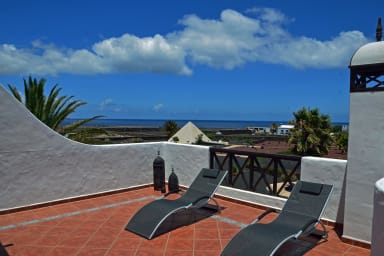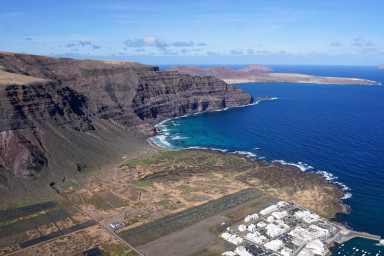
Home Casa Sueño in the Village of Mala
Orzola - Arrieta - Haria,
Phone: +34 928819600
Mobile: +34 690275334
- 2-4 People
- 2 Bedrooms
- 2 Bathrooms
- 160m²Surface

Órzola is the northernmost village on the island. Down to the volcanic rocks it is used by locals as a destination during the weekend. The arm of the sea between Lanzarote and La Graciosa, called El Río, is considered to be an area with the highest fish population.
The life and hustle and bustle in the small fishing village of Orzola is characterised by the ferry service to the small neighboring island of La Graciosa. There are 2 ships from different companies departing daily at the small port. Between 8 am and 8 pm you can go back and forth between Orzola and La Graciosa every half hour. Please note summer and wintertime timetables.
The town of Haría is the capital of the municipality of the same name on Lanzarote.
Haria lies surrounded by Volcanos, in the north of Lanzarote, in the “Valley of the Thousand Palms” and there is no other place on the whole island where canary palms grow in such a variety.
It is said that whenever a girl was born in Haría, a new palm tree grew.
Haría - Haria Lanzarote MarketHaría was often exposed to invasions and pirate attacks throughout his history. In the most devastating of 1586, almost the entire palms were burnt down. The neoclassical buildings at the Plaza de la Constitución date the 19th century, when Haría was temporarily the seat of a constituent assembly. Especially in the 1950s, when during the Franco era many inhabitants moved their homeland in Haría towards South America, Haría suffered under a land run. To this day some of the houses are empty.
Center of the village of Haría is the long, shaded Plaza León y Castillo with laurel and eucalyptus trees. At the eastern end of the square stands the Iglesia de Nuestra Señora de la Encarnación, reconstructed in 1956 after a heavy storm. Near the Plaza de la Constitución lies the Taller Municipal de Artesania handicraft center, where traditional embroidery, baskets and cloaks are made.
Around the ecclesiastical holiday of San Juan (June 24 to 27 June) colorful salt mats with different motifs are laid out on the streets. This happens during the day and one can observe the people at work before the next day a procession with St. Juan destroys these salt pictures.
In the cemetery of Haría you will find the grave of the artist and conservationist of the island, César Manrique, who moved to a farmhouse, which he rebuilt in 1988, and on 25 September 1992 in his old age Of 73 years he died after an car accident.
Haría is one of the seven municipalities of Lanzarote, with a total population of 4,755 (1 January 2015) on a total area of 106,58 km².
The address of the municipal administration is: Plaza de la Constitución, 1, 35520 – Haría,
Website: www.ayuntamientodeharia.com
If you follow LZ-1 in the direction of Jameos del Agua, you will pass the two coastal towns of Arrieta and Punta Mujeres.
Sunrays glisten on the water, small fishing boats sway to the beat of the light waves, locals cast their rods in the hope of a good catch.
ArrietaShortly before entering Arrieta, turn right to the beach Playa de la Garita, also popular with locals and very suitable for children, with access to the popular beach bar “La Casita de La Playa”. On this beach to the north you reach the second recommended bar “El Chiringuito”, with the best access from the side of Arrieta.
In Arrieta there are some good fish restaurants, pizzerias, supermarket and also a stationery shop. Also the supermarket at the gas station with a large assortment, which is also open on Sundays, directly at the entrance to the village, is really well recommended.
The two coastal towns of Arrieta and Punta Mujeres have managed to retain their charm and ambience. Small whitewashed houses with blue or green shutters dominate the village.
In Arrieta you will probably notice the house “Casa Juanita” shining in shades of blue and red. The special location of this charming building, which borders the harbour pier on one side and the Atlantic on the other, is the background of a rather sad story from the early 1920s. At that time a Lanzaroteño built this beautiful house for his lung sick daughter. She was supposed to recover by inhaling the salty sea air, but unfortunately died in early years.
In front of “Casa Juanita” is the small lagoon “El Charcón”, which with its shallow waters is the ideal place to stay, especially for families with small children.